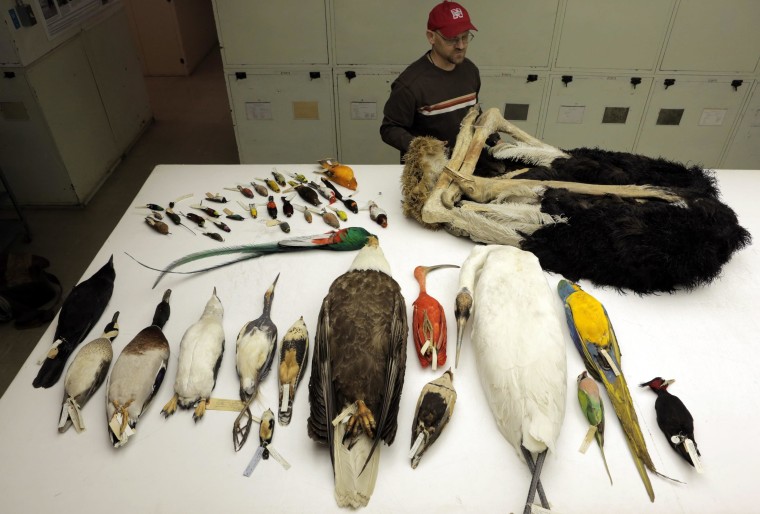The demise of the dinosaurs touched off an evolutionary “big bang” that lasted 15 million years or less and gave rise to all the types of birds we see today, according to the findings from a massive research effort involving hundreds of researchers from 20 countries.
Over the course of more than four years, the Avian Phylogenomics Consortium sequenced the genomes of 45 species representing virtually every major limb of the bird world's evolutionary family tree, which takes in more than 10,000 species around the world.
Those genomes were compared using the equivalent of 400 years of supercomputer time, and organized using a new statistical method for tracing genetic connections.
The results were as overwhelming as the scale of the project: More than two dozen research papers were published online Thursday, in Science as well as Genome Biology, GigaScience and other journals. Among the findings:
- A study of genome structure suggests that the chicken is the modern-day bird that most closely resembles the dinosaurian ancestor of birds. That finding is in line with previous analyses of proteins recovered from a Tyrannosaurus rex fossil.
- The earliest common ancestor of land birds, a category that includes parrots and finches as well as hawks and eagles, appears to have been an apex predator. "This predatory trait has been lost several times," said Duke University's Erich Jarvis, one of the project's leaders.
- Genetic comparisons suggest that brain regions in songbirds are activated in a way that's similar to the patterns seen in humans — but not similar to the patterns seen in non-singing birds or non-human primates. That analysis took advantage of the Allen Human Brain Atlas.
- The process by which the ancestors of modern birds began to lose their teeth apparently started about 116 million years ago, when dinosaurs were having their heyday.
- A parallel study of crocodilian genomes suggests that the earliest common ancestor of dinosaurs, crocodiles, alligators and birds — all members of a group of creatures known as archosaurs — lived around 240 million years ago. While birds were among the fastest-evolving members of the group, crocodilans were among the slowest to evolve.
- A comparative study of Adelie penguins and Emperor penguins points to genetic factors that could help explain why Adelie populations go through climate-related boom-and-bust patterns, while Emperor populations have stayed relatively stable.
The scientists behind the project say their findings shed dramatic new light on the evolutionary history of birds, but are almost certain to have broader application in biology and medicine as well.
For instance, insights into the genetic roots of birdsong could point researchers to new clues about the roots of human speech disorders as well. And the fact that bird genomes are more compact could help scientists zero in on more precise targets as they hunt for the genetic factors behind human traits.
"These make birds or chickens good models," said Guoxie Zhang of BGI-Shenzhen, one of the major partners in the genomics project.
A flock of genomes
Before the Avian Phylogenomics Consortium set to work, only a few bird genomes — including the codes for chickens, turkeys and zebra finches — had been deciphered. What's more, researchers knew very little about the deep genetic connections between species.
"In the past, people have been using one, two — up to 10 or 20 genes — to try to infer species relationships over the last 100 million years or so," Jarvis said in a news release. "Our theory has been, if you take the whole genome, you would have a more accurate species tree than just one or two genes alone."

Most of the whole genomes added to the list come from the biggest subdivision of the bird world, known as the Neoaves. That's the group that takes in parrots and finches, hawks and eagles (but not ostriches or chickens).
The more genomes you have, the easier it is to see the relationships between species and figure out how and when they diverged. However, there's also a greater potential for spurious information to produce a wrongly constructed evolutionary tree. To make sure their tree was solid, the bird genetics consortium developed a method known as "statistical binning" to help avoid creating misshapen trees.
Multiple runs using different tree-building methods produced a consistent picture of the bird world's evolutionary history. "This is the biggest DNA sequence tree ever generated," Jarvis told reporters during a teleconference. "In this case, it's 30 million base pairs long."
When did bird species soar?
Technically speaking, scientists regard birds as the only species of dinosaurs to survive a mass extinction that occurred 65 million years ago. Jarvis said the genetic analysis was likely to settle a longstanding debate over whether the proliferation of bird species occurred before or after the big die-off.
"We suggest it occurred right at that time, with only a few lineages surviving mass extinction, and they giving rise to ... what we call the Passerea, Columbea and Neoaves group within the last 66 million years," Jarvis said. "And all modern orders formed from this radiation within a 10- to 15-million-year period, around 50 million years ago."
The process used to organize the evolutionary tree for birds is likely to be used in the future to take a fresh look at other branches of the overall tree of life, said Tandy Warnow, a bioengineering and computer science professor at the University of Illinois who led the computational effort.
Neither Warnow nor Jarvis was willing put a cost estimate on the effort, because the expenses were shared by so many institutions as well as funders such as the National Science Foundation and the National Institutes of Health.
"It's really hard to calculate a number, but it's a really big number," Jarvis said.
The journal Science is publishing a collection of papers from the Avian Phylogenomics Project. Other papers are being published in GigaScience, Genome Biology, BMC Genomics and BMC Evolutionary Biology.